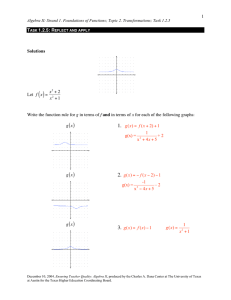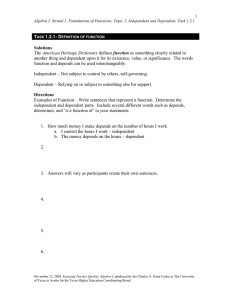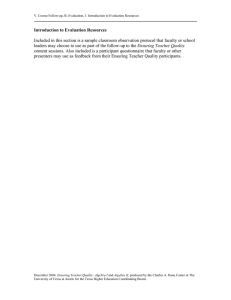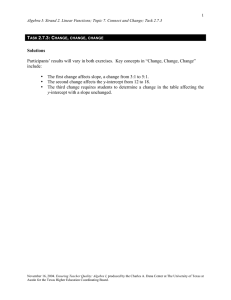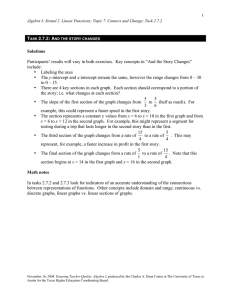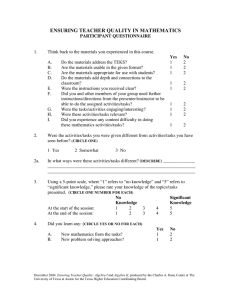1 Keep in mind that several viewing windows can be considered... intercepts, characteristics of the parent function, and end behavior, it...
advertisement
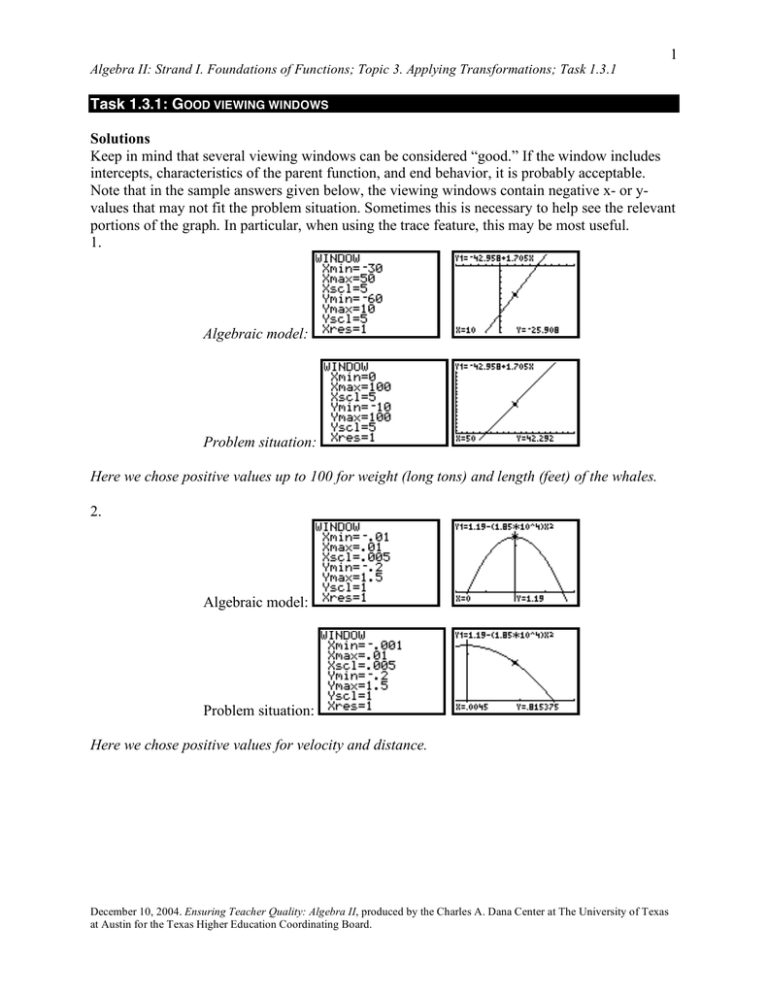
Algebra II: Strand I. Foundations of Functions; Topic 3. Applying Transformations; Task 1.3.1 1 Task 1.3.1: GOOD VIEWING WINDOWS Solutions Keep in mind that several viewing windows can be considered “good.” If the window includes intercepts, characteristics of the parent function, and end behavior, it is probably acceptable. Note that in the sample answers given below, the viewing windows contain negative x- or yvalues that may not fit the problem situation. Sometimes this is necessary to help see the relevant portions of the graph. In particular, when using the trace feature, this may be most useful. 1. Algebraic model: Problem situation: Here we chose positive values up to 100 for weight (long tons) and length (feet) of the whales. 2. Algebraic model: Problem situation: Here we chose positive values for velocity and distance. December 10, 2004. Ensuring Teacher Quality: Algebra II, produced by the Charles A. Dana Center at The University of Texas at Austin for the Texas Higher Education Coordinating Board. Algebra II: Strand I. Foundations of Functions; Topic 3. Applying Transformations; Task 1.3.1 3. Algebraic model: Problem situation: We chose positive values for volume. We chose side length values, 0 ! x ! 23 inches because after that, you have cut out more than half of the page for only one of the squares. In other words, you have run out of paper and the rest of the x-values do not make sense in the problem situation. 4. Algebraic model: Problem situation: We chose positive values for both time and amount of money. 5. a. b. December 10, 2004. Ensuring Teacher Quality: Algebra II, produced by the Charles A. Dana Center at The University of Texas at Austin for the Texas Higher Education Coordinating Board. 2 Algebra II: Strand I. Foundations of Functions; Topic 3. Applying Transformations; Task 1.3.1 3 c. d. e. f. You need one window to see the long term behavior and a different window to see the short term behavior. g. h. December 10, 2004. Ensuring Teacher Quality: Algebra II, produced by the Charles A. Dana Center at The University of Texas at Austin for the Texas Higher Education Coordinating Board. Algebra II: Strand I. Foundations of Functions; Topic 3. Applying Transformations; Task 1.3.1 4 Math notes The exercise of having to decide on good viewing windows emphasizes the importance of having a good understanding of the domain and range for a function, how the domain and range change with respect to certain transformations, and how the domain and range of an algebraic model may need to be restricted to adequately convey a problem situation. This task reinforces the questions listed in the teaching notes for Task 1.2.3. Teaching notes Have participants work in pairs to choose a “good” viewing window for the functions. Assign the Exercises 1 and 2 to half of the participants and Exercises 3 and 4 to the other half. Ask some pairs to enter their windows into the overhead calculator for each of the functions and justify their window choices. Some questions to ask are: • What is the parent function in this exercise? Participants should find viewing windows that show the parent functions (linear, quadratic, cubic, and exponential respectively). • How can you use what you know about transformations to help you find a good viewing window? In Exercise 2, the parent function, y = x 2 is reflected across the x-axis, is vertically stretched, and is shifted up 1.19. Look for an upside down parabola that for a small change in x, the y-values decrease quickly. • What is a “good” viewing window? It shows the important features of the graph. • Is there only one “good” viewing window? It may not be possible to find one good viewing window that shows all of the important features; it may be necessary to have more than one window. • What features of a function are important to show? x-, y- intercepts, characteristics of the parent function, end behavior • What strategies did you use to help you find a good viewing window? Answers might include: tracing on the function to find some function values even when the curve is off the screen, using the table feature to find function values, estimating a few function values mentally. December 10, 2004. Ensuring Teacher Quality: Algebra II, produced by the Charles A. Dana Center at The University of Texas at Austin for the Texas Higher Education Coordinating Board. Algebra II: Strand I. Foundations of Functions; Topic 3. Applying Transformations; Task 1.3.1 5 Task 1.3.1: GOOD VIEWING WINDOWS Find a good viewing window for the graph of the function rule and find a good viewing window for the graph of the problem situation. Record the window and sketch the graph: 1. A model for the relationship of the weight and length of a humpback whale is w = !42.958 + 1.705l , where l is the length in feet and w is the weight in long tons. (A long ton is about 2240 pounds.) 2. The rate at which a blood cell flows depends on the distance of the cell from the center of the artery. Research has determined that a mathematical model of this problem situation is v = 1.19 ! 1.85 " 10 4 r 2 , where r is the distance (in cm) of the blood cell from the center of the artery and v is the velocity (in cm per second). ( ) December 10, 2004. Ensuring Teacher Quality: Algebra II, produced by the Charles A. Dana Center at The University of Texas at Austin for the Texas Higher Education Coordinating Board. Algebra II: Strand I. Foundations of Functions; Topic 3. Applying Transformations; Task 1.3.1 3. The function v = 2666x ! 210x 2 + 4x 3 represents the volume of a certain box that has been made by removing equal squares of side length x inches from each corner of a rectangular sheet of material and then folding up the sides. 4. If you deposit $1000 into a savings account earning 8% interest compounded annually, the T amount of money A you would have after time T is given by A = 1000 (1.08 ) . December 10, 2004. Ensuring Teacher Quality: Algebra II, produced by the Charles A. Dana Center at The University of Texas at Austin for the Texas Higher Education Coordinating Board. 6 Algebra II: Strand I. Foundations of Functions; Topic 3. Applying Transformations; Task 1.3.1 7 5. Find a good viewing window for the following functions. Sketch the function and record the window: a. y = .005x ! 0.02 b. y = 20 ! 2 x c. y = !950x 2 + 950x ! 600 d. y = 100 x e. y = ! x ! 10 ! 6 f. y = x 3 ! 10x 2 + 33x ! 15 g. y = 1 x + 12 h. y = ln ( x ! 11) 6. Define a “good” viewing window. 7. Is there a “best” viewing window? December 10, 2004. Ensuring Teacher Quality: Algebra II, produced by the Charles A. Dana Center at The University of Texas at Austin for the Texas Higher Education Coordinating Board.
